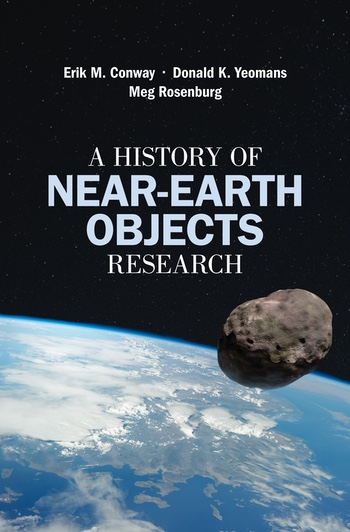Review: A History of Near-Earth Objects Researchby Jeff Foust
|
| The book makes clear that the history of NEO research is a relatively recent one. The first major search for NEOs did not start until 1973, when NASA funded the Palomar Planet-Crossing Asteroid Survey. |
DART is the first NASA mission devoted to planetary defense: while the mission will perform some science, its primary purpose is to test the effectiveness of the “kinetic impactor” approach for deflecting asteroids. It’s a far cry from less than 15 years ago, when NASA was spending less than $4 million a year on a handful of projects to search for near Earth objects (NEOs), a change driven by both science and policy, as described in the new book A History of Near-Earth Objects Research from NASA’s history office.
The book makes clear that the history of NEO research is a relatively recent one. While the first asteroid was discovered in 1801, it was nearly a century before the first near Earth asteroid, 433 Eros, was discovered. For much of the 20th century, there was little focus on studying NEOs. The first major search for NEOs did not start until 1973, when NASA funded the Palomar Planet-Crossing Asteroid Survey.
What changed in the latter decades of the 20th century to increase the rate of NEO discoveries was in part changes in technology: electronic CCDs cameras supplanted film, while computers made it easier to automate searches and detect asteroids in those electronic images. At the same time, there was a growing recognition of the threats that NEOs posed to the Earth as scientists came to understand the impact record on the Earth, from Meteor Crater in Arizona to Chicxulub in Mexico, the impact that killed off the dinosaurs 65 million years ago. Soon there were goals to discover NEOs at least one kilometer across and, in a 2005 NASA authorization act, those at least 140 meters across.
However, as is often the case for NASA programs, appropriations lagged authorizations. As late as 2009, NASA was spending less than $4 million a year on NEO search efforts. What changed that was not a new recognition of the asteroid threat but instead a change in space exploration policy: the end of the Constellation program and the Obama Administration’s intent to replace it with human missions to a near Earth asteroid, which morphed into the Asteroid Redirect Mission (ARM). While ARM never got very far, it did have the lasting effect of increasing the NEO budget at NASA by a factor of ten, to $40 million in 2014. NEO discoveries, which a decade ago were still under 1,000 a year, now routinely exceed 2,000 per year.
| The authors argue that planetary defense is an applied science, or public service of sorts, not unlike meteorology, where few begrudge the government funding the National Weather Service. |
NASA’s efforts also evolved from simply searching for NEOs to a broader “planetary defense” effort that included work to prepare for, or prevent, an impact. That includes the DART mission as well as coordination with other federal agencies. NASA now spends about $150 million a year on planetary defense, including for missions like DART as well as ongoing NEO searches.
Despite the scientific and policy success, planetary defense still has to battle for funding. NASA’s 2023 budget proposal sharply cut funding for the next planetary defense mission, a space telescope called NEO Surveyor, pushing back its planned 2026 by at least two years. Draft House and Senate spending bills would at least partially restore that funding, but not enough to avoid a delay in a mission that scientists say is essential to meeting the goal in the 2005 NASA authorization act.
A History of Near-Earth Objects Research is a thorough history of NEO studies, touching on science, technology, and policy aspects. It is also something of a defense of the field, which has sometimes been criticized for not being purely science. (One of the book’s authors, Don Yeomans, worked on NEO studies for many years at JPL.) The authors argue that planetary defense is an applied science, or public service of sorts, not unlike meteorology, where few begrudge the government funding the National Weather Service. If successful, DART could not only demonstrate a means of protecting the planet from impacts, but also protecting the planetary defense program’s budget.
Note: we are using a new commenting system, which may require you to create a new account.
